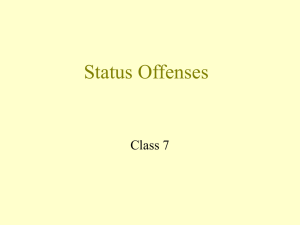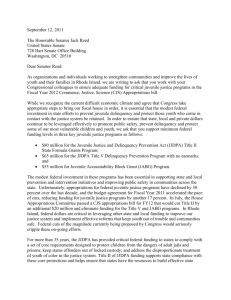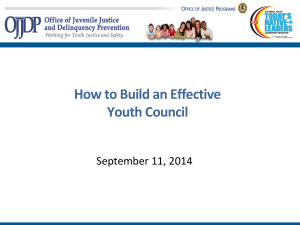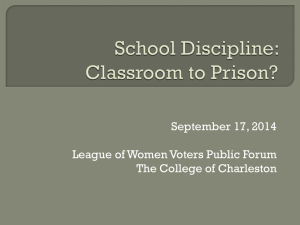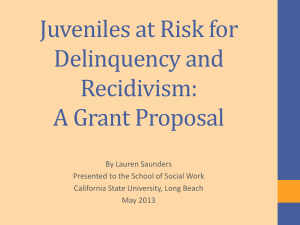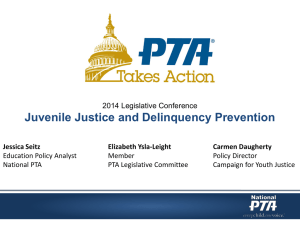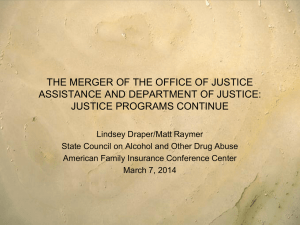Juvenile Justice Delinquency Prevention Act
advertisement
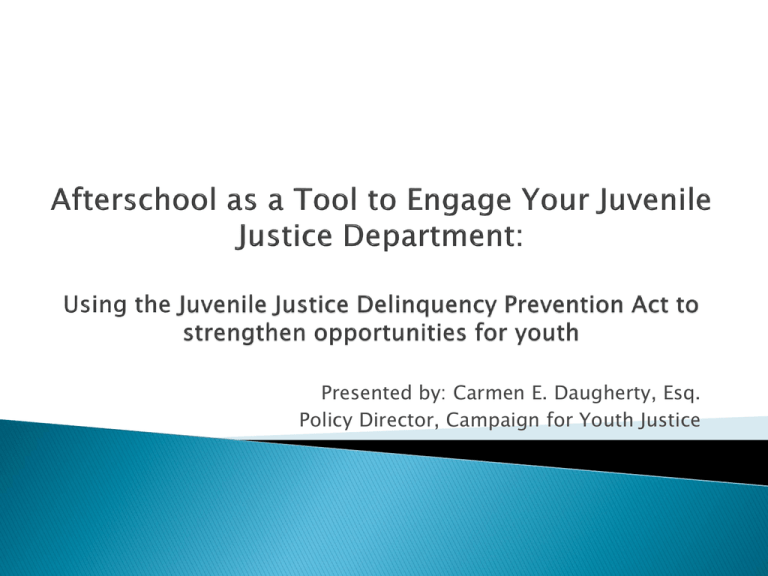
Presented by: Carmen E. Daugherty, Esq. Policy Director, Campaign for Youth Justice Established in 1974 The JJDPA is based on a broad consensus that children, youth and families involved with the juvenile and criminal courts should be guarded by federal standards for care and custody, while also upholding the interests of community safety and the prevention of victimization. 1. Deinstitutionalization of Status Offenders (DSO) Status offenses are offenses that only apply to minors whose actions would not considered offenses at the age of majority, such as skipping school, running away, breaking curfew and possession or use of alcohol. Under the JJDPA, status offenders may not be held in secure detention or confinement. There are, however, several exceptions to this rule, including allowing some status offenders to be detained for up to 24 hours. The DSO provision seeks to ensure that status offenders who have not committed a criminal offense are not held in secure juvenile facilities for extended periods of time or in secure adult facilities for any length of time. These children, instead, should receive community-based services, such as day treatment or residential home treatment, counseling, mentoring, family support and alternative education. 2. Adult Jail and Lock-up Removal Under the JJDPA, youth may not be detained in adult jails and lock-ups except for limited times before or after a court hearing (6 hours), in rural areas (24 hours plus weekends and holidays), or in unsafe travel conditions. This provision does not apply to children who are tried or convicted in adult criminal court. This provision is designed to protect children from psychological abuse, physical assault and isolation. Children housed in adult jails and lock-ups have been found to be eight times more likely to commit suicide, two times more likely to be assaulted by staff, and 50 percent more likely to be attacked with a weapon than children housed in juvenile facilities. 3. "Sight and Sound" Separation When children are placed in an adult jail or lock-up, as in exceptions listed above, "sight and sound" contact with adults is prohibited under the JJDPA. This provision seeks to prevent children from threats, intimidation or other forms of psychological abuse and physical assault. Under "sight and sound," children cannot be housed next to adult cells, share dining halls, recreation areas or any other common spaces with adults, or be placed in any circumstance that could expose them to threats or abuse from adult offenders. 4. Disproportionate Minority Contact (DMC) States are required to assess and address the disproportionate contact of youth of color at key contact points in the juvenile justice system – from arrest to detention to confinement. Studies indicate that youth of color receive tougher sentences and are more likely to be incarcerated than white youth for the same offenses. With youth of color comprising one-third of the youth population but two-thirds of youth in contact with the juvenile justice system, this provision requires states and local jurisdictions to address the reasons for such disproportionate minority contact. Juvenile Justice Funding Streams and Program Resources 1. Taxes are paid by us… 6. Funds are released to designated state agencies of qualifying states for distribution at the local level 5. Funds go from OJJDP to various programs, including Title II Formula Grants, Title V, and Discretionary Grants 2. President drafts budget OJJDP and other agencies’ input on budget development, draft budget 4. Funds go to OJJDP and many other agencies 3. Congress reviews and appropriates funds OJJDP provides funds directly to states, territories, and the District of Columbia to help them implement comprehensive state juvenile justice plans based on detailed studies of needs in their jurisdictions, as well as to achieve compliance with the core requirements of the JJDPA The goal of this program is to improve juvenile justice systems by increasing the availability and types of prevention and intervention programs, and implementing juvenile justice system improvements. Community-based approach to delinquency prevention Focuses on reducing risks and enhancing protective factors Organizes community leaders to collect and analyze community risk and resource data Must be in compliance with core requirements States are required to pass through 75 percent of award to eligible units of local government, absent a waiver from the OJJDP administrator. Document efforts to implement a system of graduated sanctions for juvenile offenders. Assist states, local government, and communities to implement accountabilitybased programs. Holds both the youth and the juvenile justice system accountable. Supports efforts from states and local jurisdictions to prohibit the sale of alcoholic beverages to minors and the purchase and consumption of alcoholic beverages by minors. Three areas of focus: ◦ Statewide task forces to target establishments ◦ Public advertising programs ◦ Innovative programs Continuum of Services for Youth and Families Problem Behavior > Noncriminal Misbehavior > Delinquency > Serious, Violent, and Chronic Offending Prevention Target Population: At-Risk Youth Programs for Programs for Youth at all Youth Greatest Risk Immediate Intervention Intervention Target Population: Delinquent Youth Intermediate Community Training Sanctions Confinement Schools Youth Development Goals: Youth Habilitation Goals: • • • • • • • • • Healthy and nurturing families Safe communities School attachment Prosocial peer relations Personal development and life skills Healthy lifestyle choices • • • Aftercare Healthy family participation Community reintegration Educational success and skills development Healthy peer network development Prosocial values development Healthy lifestyle choices Continuum of Services for Youth and Families Problem Behavior > Noncriminal Misbehavior > Delinquency > Serious, Violent, and Chronic Offending Intervention Prevention Target Population: At-Risk Youth Programs for Programs for Youth at all Youth Greatest Risk Target Population: Delinquent Youth Immediate Intermediate Community Training Sanctions Confinement Schools Formula Grants Program Intervention Aftercare Title V Program Youth Habilitation Goals: Youth Development Goals: • Healthy and nurturing families • Safe communities • School attachment • Prosocial peer relations • Personal development and life skills • Healthy lifestyle choices • • • • • • Healthy family participation Community reintegration JABG Program Educational success and skills development Healthy peer network development Prosocial values development Healthy lifestyle choices EUDL No reauthorization since 2002 No permanent Administrator Funding decreasing every year Title II formula grants were appropriated at $88.8 million in 2002 and $75 million in 2009 Title V block grants were appropriated at $94.3 million in 2002 and $62 million in 2009 In 2010, President Obama requested just $162 million for all programs under JJDPA, an $81.7 million drop since 2004. Total FY2011 Federal Investment (JABG, Title II and Title V): $9,080,788 FY2010 Federal Investment: $11,496,945 The current funding levels for juvenile justice in California represent a 23% decrease of the previous FY funding level. Total FY2012 Federal Investment (JABG and Title II) in Pennsylvania: $1,491,073 FY 2011 Federal Investment: $2,931,063 FY2010 Federal Investment: $3,614,045 JABG, Title II and Title V funding for the Commonwealth has been cut 76% since 2002. Total FY2012 Federal Investment (JABG, Title II, EUDL and Title V): $663,199 FY2011 Federal Investment: $1,380,991 The current overall funding levels for juvenile justice in Iowa represent a 54% decrease from the FY2011 funding level. Youth PROMISE Act: The bipartisan Youth Prison Reduction through Opportunity, Mentoring, Support and Education (Youth PROMISE) Act, H.R. 2721/S. 435. ◦ Aims to reduce violence in communities that have a high concentration of youth at risk of school disengagement, social disconnection and/or delinquent behavior. ◦ Provides targeted federal investments in empirically based prevention and intervention strategies, such as family strengthening programs, academic and school supports, positive youth development and other evidence based interventions such as those identified in “Blueprints for Violence Prevention.” Reauthorize the Juvenile Justice and Delinquency Prevention Act (JJDPA) The most recent, broadly supported, bipartisan proposal (S. 678) to reauthorize the JJDPA includes specific new provisions to this long‐standing law designed to increase evidence‐based screening and assessment for children and youth who come into contact with the courts, as well as to improve family and community supports and services for mental health and behavioral health. Requires an increase in Title II and Title V federal funding The Title V Incentive Grants for Local Delinquency Prevention Programs are the only federal funding source dedicated solely to the prevention of youth crime and violence. These small grants fund a range of innovative and effective programs - from home visitation by nurses and preschool/parent training programs to youth development initiatives involving the use of mentoring, after-school activities, tutoring, truancy prevention, and dropout reduction strategies. The Office of Juvenile Justice Delinquency and Prevention website: www.ojjdp.gov National Juvenile Justice & Delinquency Prevention Coalition (NJJDPC) website: http://promotesafecommunities.org/ Act 4 Juvenile Justice campaign of the NJJDP Coalition website: http://www.act4jj.org State specific fact sheets on JJDPA funding use: http://www.act4jj.org/factsheets_state.html Campaign for Youth Justice website: www.campaignforyouthjustice.org
